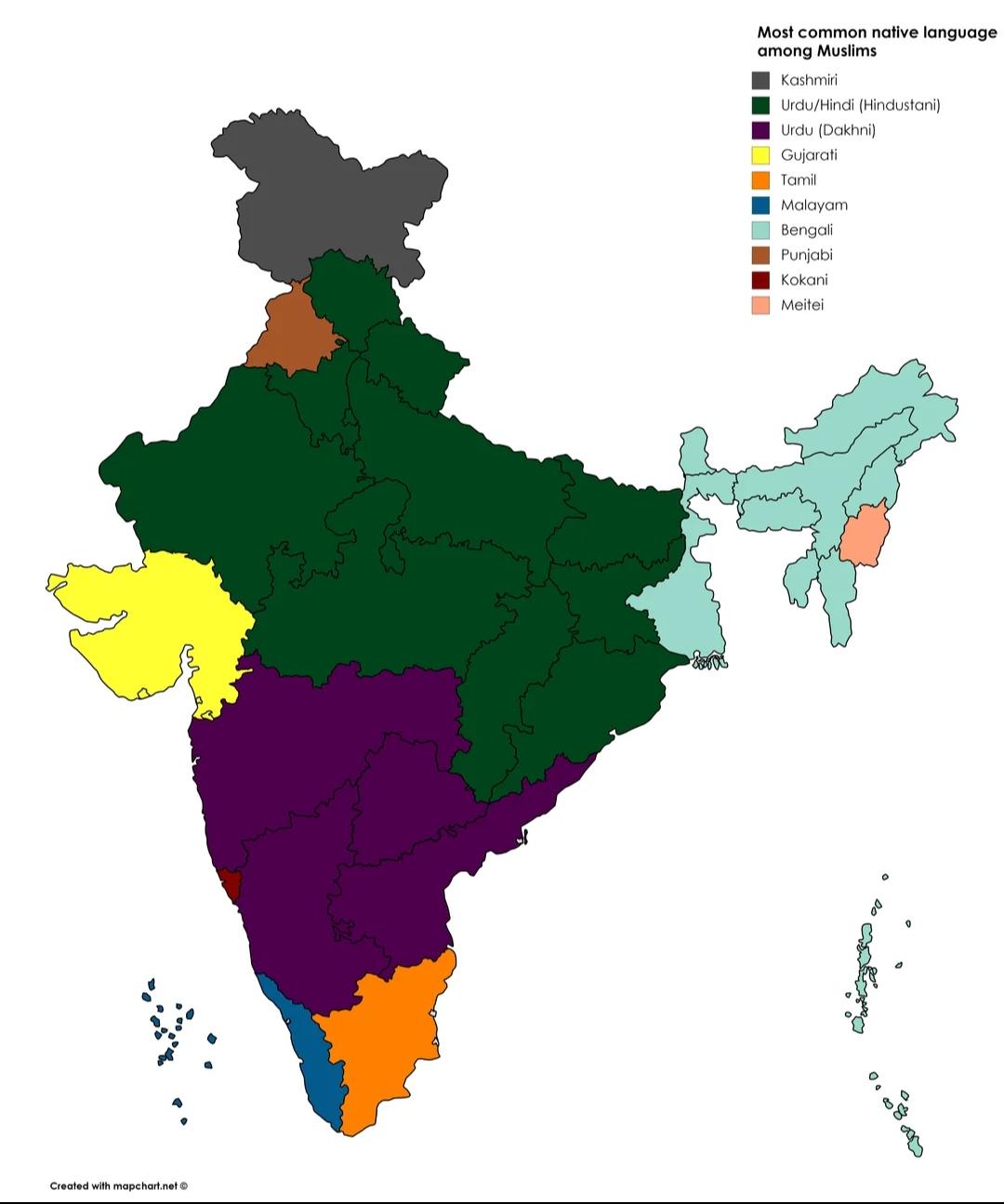Common Language Among Muslims in India Map


Marcus Rodriguez
Historical Geography Expert
Marcus Rodriguez specializes in historical cartography and geographic data analysis. With a background in both history and geography, he brings unique...
Geographic Analysis
What This Map Shows
The visualization titled "Most Common Language Among Muslims in India" offers a detailed representation of linguistic diversity within the Muslim population across various regions of India, based on data from the Census of 2011. The map highlights which languages are predominantly spoken by Muslims in different states and union territories, allowing for a clearer understanding of cultural and linguistic affiliations within this community.
Interestingly, while Hindi is often perceived as the lingua franca of India, the map reveals a more nuanced picture among the Muslim population. It illustrates the rich tapestry of languages spoken, including Urdu, Bengali, and regional dialects, showcasing how these languages not only reflect cultural heritage but also influence local identity.
Deep Dive into Language Diversity in the Muslim Community
Language is a powerful marker of identity and culture, particularly within the Muslim community in India. According to the Census 2011, a considerable number of Muslims identify Urdu as their mother tongue, making it the most widely spoken language among Muslims in the country. Urdu is not just a means of communication; it carries historical significance and is associated with the rich literary and artistic traditions of the Indian subcontinent. The language has been a medium for poets and writers, creating a vibrant cultural legacy.
However, the linguistic landscape is diverse. For instance, in states like West Bengal, Bengali emerges as a significant language among Muslims, reflecting the cultural ties to the region. In Assam, the Assamese language holds sway within the Muslim population, indicating how regional identities shape linguistic preferences.
Interestingly, the map shows that the dominance of Urdu is not uniform across the country. In states such as Kerala and Tamil Nadu, the Muslim population predominantly speaks Malayalam and Tamil, respectively. This variation is crucial, as it highlights the intersection of religion, language, and regional identity.
Moreover, smaller communities speak languages like Gujarati and Punjabi, showcasing the linguistic diversity that exists within the Muslim community. This diversity is further enriched by dialects, with many Muslims in Northern India conversing in dialects that are variations of Hindi, showcasing a blend of cultural influences.
Regional Analysis
Diving deeper into the regions depicted on the map, it’s fascinating to observe how linguistic patterns differ. In Uttar Pradesh, for instance, Urdu remains prevalent, particularly in urban areas where there is a significant Muslim population. This aligns with the state's historical significance as a center for Urdu literature and culture.
In contrast, Maharashtra presents an interesting case. While Urdu is spoken, the presence of Marathi as a common language among Muslims is noteworthy, reflecting broader social integration within the state. The same can be observed in Gujarat, where the Muslim population often uses Gujarati, illustrating how regional languages can foster community ties.
On the eastern front, states like West Bengal and Assam reveal a strong preference for local languages among Muslims, with Bengali and Assamese serving not just as communication tools but as pivotal elements of cultural identity. This regional linguistic preference can often lead to rich cultural exchanges and interactions with non-Muslim communities, thereby enhancing social cohesion.
Significance and Impact
Understanding the linguistic diversity among Muslims in India is not just an academic exercise; it has real-world implications. Language plays a crucial role in education, governance, and social integration. As India becomes increasingly urbanized, how language is used within communities can influence job opportunities, access to services, and community relations.
Moreover, recognizing these linguistic patterns can aid policymakers in creating inclusive policies that respect and promote the linguistic rights of minority communities. With the rise of globalization and digital communication, there’s also a growing trend of younger generations embracing multiple languages, potentially leading to shifts in linguistic dominance in the coming years.
In conclusion, the map illustrating the most common language among Muslims in India serves as a vital tool for understanding the complex interplay of language, culture, and identity within this diverse community. As we move forward, it’s essential to appreciate and celebrate this diversity, acknowledging that each language carries with it a wealth of history and cultural significance that enriches the Indian mosaic.
Visualization Details
- Published
- September 25, 2025
- Views
- 66
Comments
Loading comments...